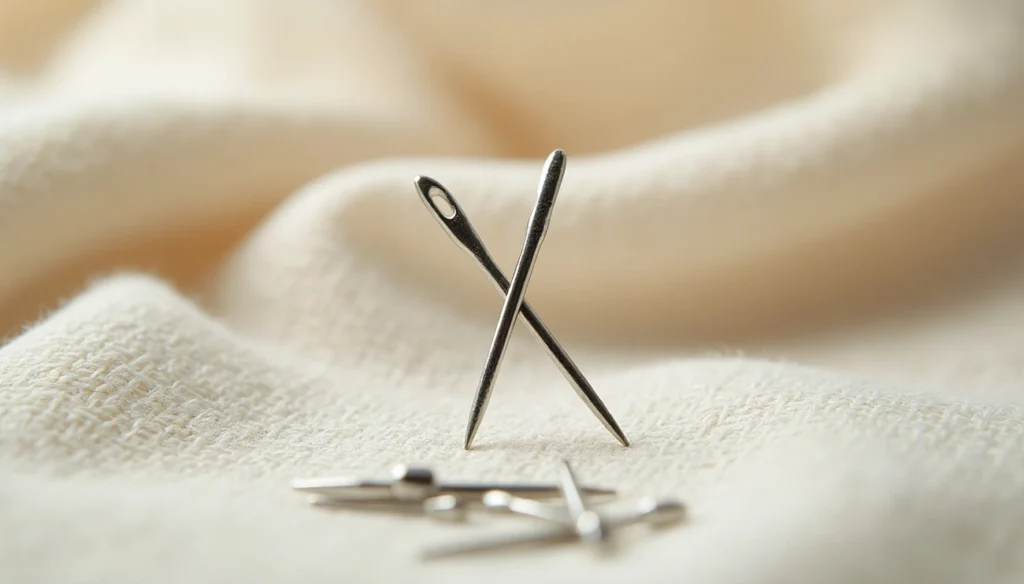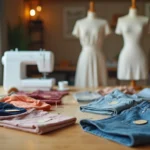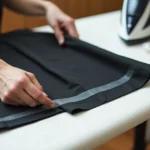No, You should not use a sewing machine needle to hand sew. Sewing machine needles lack an eye large enough for hand sewing thread and are too short and thick to handle comfortably by hand. Hand sewing needles are specifically designed with a larger eye and finer shaft for manual control.
Key differences between hand and machine needles
Understanding the key differences between hand and machine needles makes it obvious why they’re not usually interchangeable. Let’s examine these crucial distinctions that impact your sewing experience.
Needle eye and threading
The most noticeable difference between these needle types lies in the eye placement. Hand sewing needles have the eye at the opposite end from the point, whereas machine needles feature the eye near the tip. This fundamental design distinction exists because machine needles must deliver thread to the machine’s mechanism to create a stitch.
Eye size and shape vary significantly between needle types. Hand sewing needles typically have eyes proportional to their shaft diameter or gage. Embroidery needles, for instance, feature very large eyes that can hold up to six threads of regular embroidery floss. Conversely, machine needle eyes vary according to their intended purpose—universal needles have standard eyes while specialty needles like metallic or topstitch needles have larger eyes to accommodate thicker threads.
Threading these different needles requires distinct approaches. Hand needles often benefit from needle threaders—small tools with thin wire that help guide thread through the eye. Machine needles, meanwhile, are threaded through the machine’s threading mechanism, making eye placement critical to their functionality.
Needle length and flexibility
Hand and machine needles distinctly differ in their physical dimensions. Hand sewing needles typically range from short to long depending on their purpose. Betweens (quilting needles) are shorter than standard Sharps, making them ideal for quick, short stitches. Millinery needles are exceptionally long compared to conventional hand sewing needles, primarily designed for sewing firmer materials like in costume-making.
Machine needles maintain a standardized length to fit sewing machines but vary in shaft thickness according to their size number. Unlike hand needles where “the bigger the number, the finer and shorter the needle”, machine needle sizes work oppositely—larger numbers indicate thicker needles.
Flexibility is another important factor. Hand needles like beading needles are intentionally thin and somewhat flexible to navigate through small spaces. In contrast, machine needles must remain rigid to withstand the high-speed, mechanical movements of sewing machines.
Point type and fabric compatibility
Point design varies dramatically between needle types based on their intended use. Machine needles come in several point styles:
- Ball point: Features a rounded tip that pushes between knit fibers without breaking them
- Sharp point: Created for precision piercing of woven fabrics
- Cutting point: Designed specifically for leather and vinyl
Hand sewing needles offer similar specialization. Sharps have the standard pointed tip for general sewing, while tapestry needles feature blunt tips to prevent splitting threads in counted cross-stitch. Leather needles use triangular-shaped tips that cleanly pierce material without causing excess damage.
Needle selection directly impacts fabric compatibility. Using the wrong needle type can damage your fabric—ball point needles shouldn’t be used on wovens as “the blunt force will tear through the fibers”. Similarly, sharp needles might create holes in knits by cutting rather than separating fibers.
These fundamental differences explain why asking “can you use a sewing machine needle to hand sew” typically receives a negative response. Their distinct designs serve specific purposes in the sewing process, making proper needle selection essential for successful projects.
What are hand sewing needles used for?
Hand sewing needles offer remarkable versatility across numerous sewing applications. Even in our machine-dominated era, certain sewing tasks still demand the precision and control that only hand needles provide. Their specialized designs serve distinct purposes that no machine needle could effectively replace.
General repairs and hemming
Sharps needles stand as the foundation of basic hand sewing tasks. These medium-length needles with pointed tips excel at everyday mending, from patching torn garments to sewing on buttons. When hemming garments, finer sharps (sizes 11/12) create delicate, nearly invisible stitches ideal for finishing delicate fabrics.
Darning needles play an essential role in fabric repair work. Their longer bodies and enlarged eyes accommodate thicker threads or yarn, making them perfect for mending holes in woven fabrics. For especially large tears, long darners provide the extended reach necessary to span wider damaged areas.
Curved repair needles solve unique challenges that straight needles cannot—they excel at sewing 3D objects like lampshades or fabric boxes where access is limited. This demonstrates yet again why asking “can you use a sewing machine needle to hand sew” misses the point of these specialized tools.
Embroidery and decorative stitching
Embroidery (crewel) needles feature elongated eyes designed specifically to accommodate multiple strands of embroidery floss. These needles make threading significantly easier—a crucial advantage considering embroidery often requires multiple color changes.
For adding beads and sequins to fabric, beading needles prove indispensable. Their extraordinarily fine, long bodies with slender eyes allow them to pass through even the smallest bead holes. Short beading needles work best when attaching individual beads to fabric featuring additional embroidery.
Chenille needles, with their large eyes and sharp points, handle thicker decorative threads with ease. They’re ideal for ribbon embroidery and working with heavier fabrics. Tapestry needles, despite looking similar to chenille needles, feature blunt tips designed to push between fabric threads instead of piercing them—perfect for counted cross-stitch work.
Quilting and applique
Betweens (quilting needles) are noticeably shorter than other hand needles, allowing quilters to make quick, even stitches through multiple fabric layers. Their petite size provides superior control, making them perfect for the precision demanded in quilting.
Appliqué work employs two primary methods—raw edge and needle-turn appliqué. Raw edge appliqué cuts fabric precisely into desired shapes and works well for art quilts or display pieces. Needle-turn appliqué, in contrast, involves turning fabric edges underneath while stitching, creating cleaner edges on projects that will undergo frequent washing or folding.
For nearly invisible attachment in needle-turn appliqué, many artisans use slip stitches (invisible stitches) at the edges, securing shapes to background fabric with minimal visual impact.
Working with delicate or thick fabrics
Leather needles (glovers) feature distinctive triangular points designed to pierce through tough materials like leather and suede without causing excessive damage. Their unique design creates clean perforations rather than tearing the material.
Ball point needles serve as specialists for knit fabrics. Unlike sharps, their rounded tips push between the yarns of knit fabrics rather than piercing them, preventing runs, holes, or loss of stretch. This specialized design preserves the fabric’s integrity during hand sewing.
For exceptionally fine or delicate fabrics, milliners (straw) needles offer superior control. Though traditionally associated with hat-making, these long needles with round eyes excel at creating pleats and fancy stitching known as smocking.
Risks of using a machine needle for hand sewing
Attempting to use machine needles for hand sewing creates several significant risks. Even in emergency situations, knowing these potential problems might make you reconsider such improvisations.
Thread breakage and fraying
Machine needles typically have smaller eyes relative to their shaft diameter compared to hand needles. This size mismatch causes excessive friction as thread passes through the eye during hand sewing. Consequently, thread often shreds, frays, or breaks at the needle eye due to stress and friction.
Even with quality thread, the wrong needle size creates frustrating interruptions. Many sewers report that “just about every time I try to sew, the thread keeps breaking” when using inappropriate needles. This occurs because machine needles may have poorly machined eyes with sharp edges that gradually cut through thread fibers.
Increased hand strain
Hand sewing with machine needles often leads to unnecessary discomfort. Since machine needles aren’t designed for manual manipulation, they typically lack the ergonomic qualities of proper hand needles.
Experienced sewers note that hand pain develops quickly when using inappropriate needles. Many must “stop every 15 minutes or so and give my hands a break”. Switching to proper hand needles – like straw needles for certain applications – can immediately reduce discomfort.
Poor stitch quality
Machine needles used for hand sewing generally produce inferior results. Without the machine’s tension system and feed dogs, these needles struggle to create consistent stitches. The wrong needle size or type for your fabric essentially guarantees poor stitch formation.
Needles inappropriate for specific fabrics inevitably lead to quality issues. For instance, a needle too thin for dense fabrics will bend slightly with each stitch, creating uneven tensions and wobbly stitch lines.
Needle snapping or bending
Perhaps most concerning, machine needles may unexpectedly break during hand sewing. These needles are designed to withstand vertical machine movements, not the varied angles of hand sewing.
Machine needles can become bent or dull from improper use, making them “more likely to break”. When needles break during use, they potentially create sharp fragments that pose safety hazards. Furthermore, even slightly bent needles can damage fabric by creating unintended holes or snags.
When (if ever) can you use a machine needle by hand?
While machine needles aren’t designed for hand sewing, certain exceptional circumstances may justify their use. Nevertheless, knowing when these rare exceptions occur can help in genuine pinch situations.
Emergency fixes
In true emergency scenarios, using a machine needle by hand might be your only option. Emergency sewing kits often include specialized tools like curved upholstery needles that can handle urgent repairs. These unique needles serve a purpose in survival situations where maintaining clothing or gear becomes critical.
Consider these legitimate emergency scenarios:
- Repairing torn outdoor gear during a camping trip
- Fixing a clothing malfunction before an important presentation
- Mending protective equipment when alternatives aren’t available
Granted, these situations represent genuine emergencies rather than mere convenience. Even in such cases, be prepared for less-than-ideal results and exercise extra caution to prevent needle breakage.
Very short stitching tasks
Occasionally, extremely brief stitching tasks might justify using a machine needle by hand. This primarily applies to situations requiring just a few stitches where the drawbacks of using an improper tool are minimized by the task’s brevity.
Short-term applications might include tacking a hem temporarily or securing a small tear until proper tools become available. Indeed, the brevity of these tasks reduces (but doesn’t eliminate) the risks associated with using machine needles by hand.
Remember that even short tasks can cause thread breakage or hand strain, making this approach suitable only when alternatives don’t exist.
Using thicker machine needles with caution
Fortunately, among machine needles, the thicker varieties pose fewer risks when used manually. Upholstery-grade machine needles tend to be sturdier and less prone to breaking during hand use.
As one expert advises, you should visually inspect any needle before use—machine or hand—to ensure the tip and shank remain in good condition. Machine needles should never be used by hand if they show any signs of bending, as bent needles increase both safety risks and the likelihood of damaging your project.
Ultimately, while emergency situations may necessitate improvisation, investing in proper hand sewing needles remains the wisest approach for quality results and sewing comfort.
Conclusion
Throughout this exploration of sewing needles, we’ve uncovered the truth behind a seemingly simple question. Machine needles and hand sewing needles serve distinctly different purposes, despite their superficial similarities. The eye placement, length, flexibility, and point types fundamentally distinguish these tools from one another.
Hand sewing needles exist in remarkable variety for good reason. Each type—whether Sharps for general repairs, Betweens for quilting, or Beading needles for decorative work—has been carefully designed to excel at specific tasks. This specialization allows sewers to achieve professional results across diverse projects.
Certainly, the risks of substituting machine needles for hand sewing become clear when we consider thread breakage, hand strain, poor stitch quality, and potential needle damage. These drawbacks outweigh any convenience gained from such improvisation.


